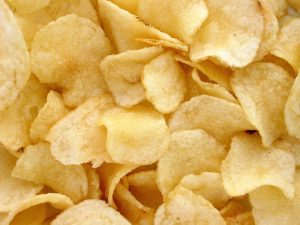Have you eaten any fried potato product recently? You do know how unhealthy those things are, right? Not only because of the fat and carbohydrate and sodium content, but possibly because of the presence of acrylamide. Acrylamide is a potent neurotoxin and a possible carcinogen, which is often used in laboratories for making gels to separate proteins. [1]

Potato chips, also known as potato crisps, are a fried potato product that may have unhealthy levels of acrylamide. Credits: Wikimedia
This acrylamide is formed as a result of the Maillard reaction, where reducing sugars and amino acids react at high temperatures to form other products. [2] The Maillard reaction is also responsible for the browning of meats at high temperature, which is often considered desirable in the culinary arts for the flavour it imparts. Especially important in this context is the presence of high levels of asparagine in potato and wheat. Through a complex sequence of reactions, asparagine and sugars may react to form acrylamide.
To reduce these levels, the enzyme asparaginase may be used. Asparaginase catalyzes the conversion of asparagine to aspartate, thus lowering the amount of asparagine available to form acrylamide. [3] This technique is already used in the food industry to reduce the levels of acrylamide, purportedly making them healthier.
Asparaginase is also used in chemotherapy to treat acute myeloid leukemia and acute lymphoblastic leukemia. [4] [5] Some cancers lack the ability to produce sufficient asparagine due to low levels of asparagine synthase, and thus depend on taking up asparagine from their environment. As such, by breaking down asparagine, the growth of these cancer cells can be slowed. Since normal cells still have asparagine synthase, they are not as affected by the asparagine. [6] However, this treatment is not perfect as asparaginase isolated from bacteria may result in immune responses against it, and it does not work against all cancers.
This enzyme, with a seemingly simple role of breaking down asparagine, has found many roles in different industries! In a sense, both of the functions described above are protecting against cancer: one through reducing carcinogen levels in food, and one through reducing nutrient levels in cancer cells. That said, don’t even think of using potato chips to try and treat cancers!
Sources:
[1] Palazoğlu TK, Savran D, Gökmen V. Effect of cooking method (baking compared with frying) on acrylamide level of potato chips. J Food Sci. 2010;75(1):E25-29. doi:10.1111/j.1750-3841.2009.01389.x
[2] Rommens CM, Yan H, Swords K, Richael C, Ye J. Low-acrylamide French fries and potato chips. Plant Biotechnol J. 2008;6(8):843-853. doi:10.1111/j.1467-7652.2008.00363.x
[3] Onishi Y, Prihanto AA, Yano S, Takagi K, Umekawa M, Wakayama M. Effective treatment for suppression of acrylamide formation in fried potato chips using L-asparaginase from Bacillus subtilis. 3 Biotech. 2015;5(5):783-789. doi:10.1007/s13205-015-0278-5
[4] Kaspers GJL. Acute myeloid leukaemia niche regulates response to L‐asparaginase. Br J Haematol. 2019;186(3):397-399. doi:10.1111/bjh.15924
[5] Sugimoto K, Suzuki HI, Fujimura T, et al. A clinically attainable dose of L-asparaginase targets glutamine addiction in lymphoid cell lines. Cancer Sci. 2015;106(11):1534-1543. doi:10.1111/cas.12807
[6] Fernandes HS, Teixeira CSS, Fernandes PA, Ramos MJ, Cerqueira NMFSA. Amino acid deprivation using enzymes as a targeted therapy for cancer and viral infections. Expert Opinion on Therapeutic Patents. 2017;27(3):283-297. doi:10.1080/13543776.2017.1254194
